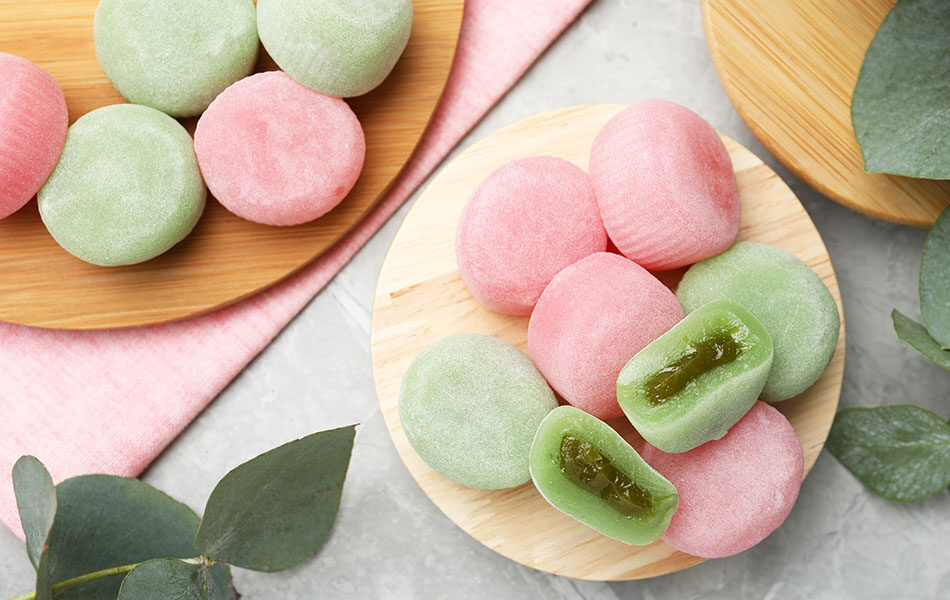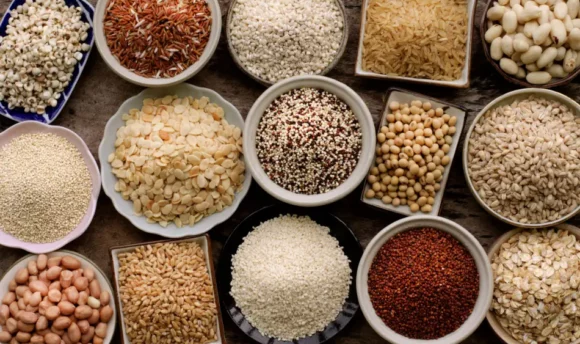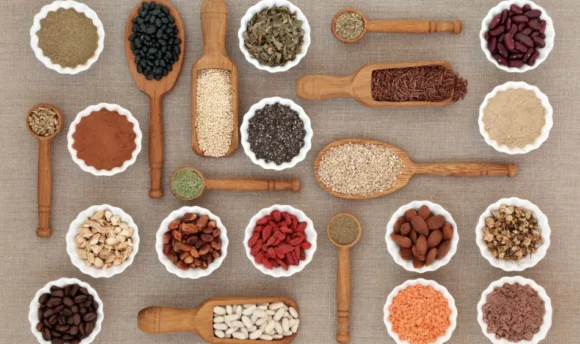Is Mochi Healthy? The Full Guide on Japanese Rice Cakes
Mochi is a Japanese snack taking the world by storm. Curious to know what it is and what you can expect when eating it? Here’s everything you need to know.

Rice isn’t only best served with soy sauce! Mochi is a surprisingly delicious sweet treat that is gaining worldwide momentum.
It’s possible you’ve seen it being served in your favorite Japanese restaurant and wondered what exactly it is. Or maybe you’re a mochi enthusiast interested in learning more about this tasty treat’s origins and nutritional information.
Either way, in this article, you’ll learn everything you need to know about mochi, from how it’s made to an in-depth analysis of its nutritional value.
What Is Mochi?
Mochi is a Japanese rice cake with a sweet filling and exterior created from a dough made from glutinous rice. It originated as a traditional food mostly consumed around the Japanese New Year but has now gained worldwide popularity.
Is Mochi Healthy?
It generally depends on what the mochi is filled with. However, we wouldn’t recommend consuming mochi because it contains too many carbohydrates. People with diabetes should especially avoid this snack.
If you are thinking about having a bite of mochi, pick the traditional one. Traditional mochi is eaten with seaweed and red bean paste which is considered a healthier alternative than an ice cream mochi.
Potential Dangers of Eating Too Much Mochi
Although delicious, eating too much mochi has potential negative side effects, which are most easily avoided by limiting yourself to 1–2 servings.
#1 Possible bowel obstruction
Most mochi eaters will likely benefit from the amount of fiber and starch in mochi, which can actually positively affect digestion. But eating too much mochi can lead to bowel obstruction because the main ingredient is amylopectin, a substance that is difficult for the body to digest.
#2 Unwanted weight gain
Eating in a calorie surplus is a recipe for weight gain, especially when the consumed food is high in carbohydrates. A calorie surplus from eating starchy foods like mochi is shown to cause significant weight increases compared to foods high in protein.
Nutrition Facts of Mochi
Nutritional value per 100g
| Calories/Nutrients | Amount |
| Calories (kcal) | 279 |
| Net Carbs (g) | 52.9 |
| Fiber (g) | 0.7 |
| Sugar (g) | 31.1 |
| Fats (total) | 5.61 |
| Protein (g) | 2.49 |
| Cholesterol (mg) | 0 |
Source: https://fdc.nal.usda.gov/fdc-app.html#/food-details/2343828/nutrients
High in calories
The recommended average daily calorie intake for men is 2,500 and 2,000 for women. Depending on the type of mochi you eat – ice cream mochi is obviously higher in calories – each portion will land you between 100–300 calories.
When you eat mochi, it’s best to limit yourself to 1–2 snacks to avoid eating in a calorie surplus.
Low in protein
Mochi, especially that which is made with ice cream, is mostly sweet rice flour and sweetened dairy. Because of this, it is high in carbohydrates but extremely low in protein. A single serving contains 2.5g of protein, 3% of the average person’s recommended daily intake.
Moderate amount of fats
The amount of fat contained in your Japanese rice cake will once again be dependent on the filling. Traditional mochi made with seaweed or anko is low in fat, but the dairy content in ice cream mochi makes it a fattier alternative. It’s something to be aware of if you’re trying to lose weight.
High carbs and sugar
All mochi is high in carbs and relatively high in sugar – depending on the filling. Carbs are nothing to be afraid of and are actually an important fuel for our bodies. They don’t lead to unwanted weight gain unless eaten out of moderation.
The carbohydrate content in glutinous rice flour, the main ingredient in mochi, also makes it an incredibly filling snack.
Zero cholesterol
Traditional mochi, made of short-grain glutinous rice and no sweet filling, has virtually no cholesterol. But eating mochi with an ice cream center will bring you close to 10% of your recommended amount of cholesterol.
Mochi vs. Daifuku
When it comes to Japanese desserts, mochi and daifuku are almost indistinguishable, with the most obvious difference being whether or not they’re stuffed.
Daifuku is, simply put, stuffed mochi. The most common daifuku filling is anko, also known as red bean paste. While daifuku is always mochi, mochi is not always daifuku.
| Mochi | Daifuku | |
| Key benefits | Can be eaten sweet and with a savory meal High in fiber Chewy texture | Higher in sugar Filling often contains beans, which are high in protein Generally eaten within 24 hours |
| Pros | Can be stuffed with a variety of fillings Can be stored in the freezer and reheated in the oven | Thinner dough exterior in comparison to mochi |
| Cons | Plain tasting when compared to daifuku High in carbohydrates | Not all filling types are healthy |
Healthy Mochi Recipe
You might be familiar with mochi ice cream, a dessert made with a mochi dough exterior and a sweet treat filling. Although this mochi ice cream is undoubtedly delicious, we recommend creating a healthier alternative akin to a traditional Japanese rice cake.
The healthiest mochi will be that which is made at home, using natural, high-quality ingredients. The sweet bean paste center in this recipe is a healthier but equally delicious alternative to popular mochi ice cream.
Ingredients
- 1 cup red bean paste, sweetened
- 1 cup glutinous rice flour
- 1 tsp green tea powder (optional)
- 1 cup hot water
- ¼ cup white sugar
- ½ cornstarch (used to roll the dough)
Directions
Step 1:
Wrap the red bean paste in tin foil and place it in the freezer until solid for at least 1 hour.
Step 2:
Combine glutinous rice flour and green tea powder in a microwave-safe bowl. Mix in hot water and sugar, and then whisk until light and fluffy.
Step 3:
Cover the bowl with plastic wrap and microwave for 3 minutes, uncovering the mixture every 60 seconds to stir before re-covering it and microwaving again. The mixture should be slightly translucent by the end. If yours isn’t, microwave for an extra 15–30 seconds.
Step 4:
Remove red bean paste from the freezer and roll it into 8 equally sized balls.
Step 5:
Dust the work surface with the cornstarch. Roll 2 tablespoons of the rice flour mixture into a ball. Flatten the ball and place the red bean paste in the middle. Pinch and press the dough around the bean paste until there are no gaps. Sprinkle with additional cornstarch before placing the finished mochi seam-down in a muffin liner to prevent sticking.
Step 6:
Repeat step 5 to make the remaining mochi.
Looking for healthier alternatives of Japanese snacks? We would recommend checking the best nutrition apps that can help you to find the best snack substitutes and reach your fitness goals.
FAQs
Traditional Japanese mochi is made from simple ingredients, low in saturated fat and cholesterol. Mochi ice cream is higher in fats and cholesterol because of its dairy content.
By limiting your portion size and avoiding mochi ice cream – a fattier alternative to traditional Japanese rice cakes – you can enjoy this delicious treat without compromising your weight loss goals.
In Japan, mochi is a traditional dessert symbolizing good fortune that is widely consumed during the Japanese New Year. Around the world, mochi has gained popularity because of its unique taste and texture, which makes it an exotic dessert option.
Use your fingers (be ready for them to be sticky) or stick to a fork and knife. Don’t try to eat an entire mochi in one bite.
A Word From a Nutritionist
Is mochi dangerous? It might not seem like it, but this sweet treat is actually quite the choking hazard! So much so that the Japanese authorities release a yearly statement reminding mochi lovers to chew carefully and swallow slowly.
Sticky rice and glutinous rice flour can easily become lodged in your airway if you’re not careful. While this risk isn’t serious enough that you should avoid consuming mochi altogether, it’s something to keep in mind while indulging in this tasty snack.
To avoid this risk, cut your mochi into small bite-sized pieces before eating it, take a sip of water after each bite, and always take time for careful chewing.
Conclusion
Although mochi doesn’t offer a lot in the realm of nutritional value, there’s no arguing that it’s a delicious snack that deserves its place on your plate.
Sticking to a regular workout schedule is the best way to reach your fitness goals while still indulging in your favorite snacks.

















































 Select your language:
Select your language: 








